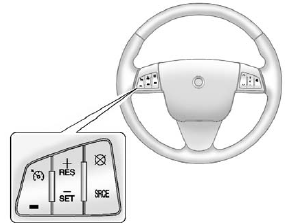Cruise Control
WARNING!
Cruise control can be dangerous
where you cannot drive safely at
a steady speed. So, do not use
the cruise control on winding
roads or in heavy traffic.
Cruise control can be dangerous
on slippery roads. On such roads,
fast changes in tire traction can
cause excessive wheel slip, and
you could lose control. Do not use
cruise control on slippery roads.
With cruise control, a speed of about 40 km/h (25 mph) or more can be maintained without keeping your foot on the accelerator. Cruise control does not work at speeds below about 40 km/h (25 mph).
When the brakes are applied, the cruise control turns off.
If the vehicle has the Stabilitrak® system and begins to limit wheel spin while you are using cruise control, the cruise control will automatically disengage. See StabiliTrak® System.
When road conditions allow you to safely use it again, the cruise control can be turned back on.

CTS Shown, CTS–V Similar
The cruise control buttons are located on the left side of the steering wheel.
 (On/Off): Turns the system on
or off. The indicator light on the
button turns on when cruise control
is on.
(On/Off): Turns the system on
or off. The indicator light on the
button turns on when cruise control
is on.
+RES (Resume/Accelerate):
Press briefly to make the vehicle resume to a previously set speed, or press and hold to accelerate.
−SET (Set/Coast): Press to set the speed and activate cruise control or make the vehicle decelerate.
 (Cancel): Press to disengage
cruise control without erasing the
set speed from memory.
(Cancel): Press to disengage
cruise control without erasing the
set speed from memory.
See also:
Audio System
When using the Bluetooth system, sound comes through the vehicle's front
audio system speakers and overrides the audio system.
Use the VOL/ knob during a call to change the volume
level.
The a ...
Driving On Grades
Reduce speed and shift to a
lower gear before starting down a
long or steep downgrade. If the
transmission is not shifted down,
the brakes might have to be used
so much that they would get h ...
Leaving After Parking on a Hill
1. Apply and hold the brake pedal
while you:
1.1. Start the engine.
1.2. Shift into a gear.
1.3. Release the parking brake.
2. Let up on the brake pedal.
3. Drive slowly until the trailer is
...






